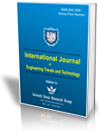Computer Imaging of Alopecia Areata and Scalp Detection: A Survey
Computer Imaging of Alopecia Areata and Scalp Detection: A Survey |
||
 |
 |
|
| © 2022 by IJETT Journal | ||
| Volume-70 Issue-8 |
||
| Year of Publication : 2022 | ||
| Authors : C. Saraswathi, B. Pushpa |
||
| DOI : 10.14445/22315381/IJETT-V70I8P236 | ||
How to Cite?
C. Saraswathi, B. Pushpa, "Computer Imaging of Alopecia Areata and Scalp Detection: A Survey," International Journal of Engineering Trends and Technology, vol. 70, no. 8, pp. 347-358, 2022. Crossref, https://doi.org/10.14445/22315381/IJETT-V70I8P236
Abstract
Alopecia Areata (AA) is a frequent inflammatory affliction that causes erratic Hair Loss (HL). As with other
resistant-influenced disorders, the development of AA is assumed to be the result of a complicated balance between
surroundings and heredity. Various factors can cause hair loss, and trichoscopies and biopsies are usually required to
ensure the cause of AA. There is currently no remedy for AA, although doctors can recommend various medications to
support hair regrowth rapidly. AA does not immediately cause illness and is not communicable, but it is tough to adjust
psychologically. Further, many people's experience with AA is regarded as a terrible infection that needs counselling for
the mental and physical components of HL. So, an efficient HL detection system should be developed to tackle this
emotional perceptive. Detecting the AA detection with scalp condition is required to find out the cause of AA level and can
provide guidance for proper treatment. Computer vision using deep learning techniques is gaining significant attention
because of improved performance over previous approaches. This article presents detailed analyses of different AA
detection approaches using (Artificial Intelligence) AI techniques with modern Deep learning. First, AI-based frameworks
designed by researchers in the past for different AA are studied briefly. After that, a comparative study is conducted to
understand those frameworks' drawbacks and suggest new solutions to improve the AA detection system.
Keywords
Artificial Intelligence, Alopecia Areata, Hair Loss (HL), Scalp Condition, Detection System.
Reference
[1] Harrison, S., & Bergfeld, W. F, “Diseases of the hair and nails,” Medical Clinics, vol. 93, no. 6, pp. 1195-1209.
[2] R. Surendiran, M. Thangamani, C. Narmatha, M. Iswarya, "Effective Autism Spectrum Disorder Prediction to Improve the
Clinical Traits using Machine Learning Techniques", International Journal of Engineering Trends and Technology, vol. 70, no. 4,
pp. 343-359, 2022. https://doi.org/10.14445/22315381/IJETT-V70I4P230.
[3] R. Surendiran, K.Alagarsamy, "Skin Detection Based Cryptography in Steganography (SDBCS)," International Journal
of Computer Science and Information Technologies, vol. 1, no. 4, pp. 221-225, 2010.
[4] Liu, L. Y., King, B. A., & Craiglow, B. G., “Health-Related Quality of Life (Hrqol) Among Patients with Alopecia Areata (AA):
A Systematic Review,” Journal of the American Academy of Dermatology, vol. 75, no. 4, pp. 806-812, 2016.
[5] Williams, J. V., Eichenfield, L. F., Burke, B. L., Barnes-Eley, M., & Friedlander, S. F, “Prevalence of Scalp Scaling in Prepubertal
Children,” Pediatrics, vol. 115, no. 1, pp. 1-6, 2005.
[6] R. Surendiran, M. Thangamani M, S. Monisha S, P. Rajesh, " Exploring the Cervical Cancer Prediction by Machine Learning and
Deep Learning with Artificial Intelligence Approaches," International Journal of Engineering Trends and Technology, vol. 70, no.
7, pp. 94-107, 2022. https://doi.org/10.14445/22315381/IJETT-V70I7P211.
[7] R. Surendiran, R. Aarthi, M. Thangamani, S. Sugavanam, R. Sarumathy, " A Systematic Review using Machine Learning
Algorithms for Predicting Preterm Birth," International Journal of Engineering Trends and Technology, vol. 70, no. 5, pp. 46-59,
2022. https://doi.org/10.14445/22315381/IJETT-V70I5P207.
[8] Chourasiya, S., & Jain, S, “A Study Review on Supervised Machine Learning Algorithms,” SSRG International Journal of
Computer Science and Engineering, vol. 6, no. 8, pp. 16-20, 2019.
[9] Sacha, J. P., Caterino, T. L., Fisher, B. K., Carr, G. J., Youngquist, R. S., D’Alessandro, B. M., & Davis, M. G, “Development and
Qualification of a Machine Learning Algorithm for Automated Hair Counting,” International Journal of Cosmetic Science, vol.
43, pp. S34-S41, 2021.
[10] Gupta, A. K., Ivanova, I. A., & Renaud, H. J., “How Good is Artificial Intelligence (AI) at Solving Hairy Problems?, A Review of
AI Applications in Hair Restoration and Hair Disorders,” Dermatologic Therapy, vol. 34, no. 2, pp. 1-9, 2021.
[11] Gao, M., Wang, Y., Xu, H., Xu, C., Yang, X., Nie, J., & Jiang, Y, “Deep Learning-Based Trichoscopic Image Analysis and
Quantitative Model for Predicting Basic and Specific Classification in Male Androgenic Alopecia,” Acta Dermato-Venereologica,
pp. 1-6, 2021.
[12] Misery L, Rahhali, N., Ambonati, M., Black, D., Saint‐Martory, C., Schmitt, A. M., & Taieb, C, “Evaluation of Sensitive Scalp
Severity and Symptomatology by using a New Score,” Journal of the European Academy of Dermatology and Venereology, vol.
25, no. 11, pp. 1295-1298, 2011.
[13] Esfandiari, A., Kalantari, K. R., & Babaei, A, “Hair Loss Diagnosis using Artificial Neural Networks,” International Journal of
Computer Science Issues (IJCSI), vol. 9, no. 5, pp. 174, 2012.
[14] Shih, H. C, “An Unsupervised Hair Segmentation and Counting System in Microscopy Images,” IEEE Sensors Journal, vol. 15,
no. 6, pp. 3565-3572, 2014.
[15] Kibar, M., Aktan, Ş., Lebe, B., & Bilgin, M., “Trichoscopic Findings in Alopecia Areata and their Relation to Disease Activity,
Severity and Clinical Subtype in Turkish Patients,” Australasian Journal of Dermatology, vol. 56, no. 1, pp. e1-e6, 2015.
[16] Jang, Y. H., Moon, S. Y., Lee, W. J., Lee, S. J., Lee, W. K., Park, B. C., & Kim, H, “Alopecia Areata Progression Index, A
Scoring System for Evaluating Overall Hair Loss Activity in Alopecia Areata Patients with Pigmented Hair: A Development and
Reliability Assessment,” Dermatology, vol. 232, no. 2, pp. 143-149, 2016.
[17] Kim, H., Kim, W., Rew, J., Rho, S., Park, J., & Hwang, E, “Evaluation of Hair and Scalp Condition Based on Microscopy Image
Analysis,” In IEEE International Conference on Platform Technology and Service, pp. 1-4, 2017.
[18] Mkentane, K., Van Wyk, J. C., Sishi, N., Gumedze, F., Ngoepe, M., Davids, L. M., & Khumalo, N. P., “Geometric Classification
of Scalp Hair for Valid Drug Testing, 6 More Reliable Than 8 Hair Curl Groups,” PLoS One, vol. 12, no. 6, pp. 1-10, 2017.
[19] Liu, L. Y., & King, B. A., “Tofacitinib for the Treatment of Severe Alopecia Areata in Adults and Adolescents,” In Journal of
Investigative Dermatology Symposium Proceedings, vol. 19, no. 1, pp. S18-S20, 2018.
[20] Dubey, K., Srivastava, V., & Mehta, D. S, “Automated in Vivo Identification of Fungal Infection on the Human Scalp Using
Optical Coherence Tomography and Machine Learning,” Laser Physics, vol. 28, no. 4, pp. 1-6, 2018.
[21] Su, J. P., Chen, L. B., Hsu, C. H., Wang, W. C., Kuo, C. C., Chang, W. J., & Lee, D. H., “An Intelligent Scalp Inspection and
Diagnosis System for Caring Hairy Scalp Health,” In IEEE 7th Global Conference on Consumer Electronics, pp. 507-508, 2018.
[22] Wang, W. C., Chen, L. B., & Chang, W. J., “Development and Experimental Evaluation of Machine-Learning Techniques for an
Intelligent Hairy Scalp Detection System,” Applied Sciences, vol. 8, no. 6, pp. 1-28, 2018.
[23] Lee, S. H., & Yang, C. S., “An Intelligent Hair and Scalp Analysis System Using Camera Sensors and Norwood-Hamilton
Model,” International Journal of Innovative Computing, Information and Control, vol. 14, no. 2, pp. 503-518, 2018.
[24] Bernardis, E., & Castelo-Soccio, L, “Quantifying Alopecia Areata via Texture Analysis to Automate the Salt Score Computation,”
In Journal of Investigative Dermatology Symposium Proceedings, vol. 19, no. 1, pp. S34-S40, 2018.
[25] Kapoor, I., & Mishra, A, “Automated Classification Method for Early Diagnosis of Alopecia using Machine Learning,” Procedia
Computer Science, vol. 132, pp. 437-443, 2018.
[26] Lee, S., Kim, B. J., Lee, C. H., & Lee, W. S., “Topographic Phenotypes of Alopecia Areata and Development of a Prognostic
Prediction Model and Grading System: A Cluster Analysis,” JAMA Dermatology, vol. 155, no. 5, pp. 564-571, 2018.
[27] Benhabiles, H., Hammoudi, K., Yang, Z., Windal, F., Melkemi, M., Dornaika, F., & Arganda-Carreras, I., “Deep Learning Based
Detection of Hair Loss Levels from Facial Images,” In IEEE Ninth International Conference on Image Processing Theory, Tools
and Applications, pp. 1-6, 2019.
[28] Muhammad, S. A., Fatima, N., Paracha, R. Z., Ali, A., & Chen, J. Y., “A Systematic Simulation-Based Meta-Analytical
Framework for Prediction of Physiological Biomarkers in Alopecia,” Journal of Biological Research-Thessaloniki, vol. 26, no. 1,
pp. 1-16, 2019.
[29] Seo, S., & Park, J, “Trichoscopy of Alopecia Areata: Hair Loss Feature Extraction and Computation using Grid Line Selection and
Eigenvalue,” Computational and Mathematical Methods in Medicine, vol. 2020, pp. 1-9, 2020.
[30] Ibrahim, S., Noor Azmy, Z. A., Abu Mangshor, N. N., Sabri, N., Ahmad Fadzil, A. F., & Ahmad, Z, “Pre-Trained Classification
of Scalp Conditions using Image Processing,” Indonesian Journal of Electrical Engineering and Computer Science, vol. 20, no. 1,
pp. 138-144, 2020.
[31] Chang, W. J., Chen, L. B., Chen, M. C., Chiu, Y. C., & Lin, J. Y., “ScalpEye: A Deep Learning-Based Scalp Hair Inspection and
Diagnosis System for Scalp Health,” IEEE Access, vol. 8, pp. 134826-134837, 2020.
[32] Lee, S., Lee, J. W., Choe, S. J., Yang, S., Koh, S. B., Ahn, Y. S., & Lee, W. S., “Clinically Applicable Deep Learning Framework
for Measurement of the Extent of Hair Loss in Patients with Alopecia Areata,” JAMA Dermatology, vol. 156, no. 9, pp. 1018-
1020, 2020.
[33] Dominique, V. N., “Exhaustive Analysis of Scalp Hair Regression: Subjective and Objective Perception from Initial Hair Loss to
Severe Miniaturization and Drug-Induced Regrowth,” Plastic and Aesthetic Research, vol. 8, pp. 1-34, 2021.
[34] Shakeel, C. S., Khan, S. J., Chaudhry, B., Aijaz, S. F., & Hassan, U., “Classification Framework for Healthy Hairs and Alopecia
Areata: A Machine Learning (ML) Approach,” Computational and Mathematical Methods in Medicine, pp. 1-10, 2021.
[35] Zhang, T., & Nie, Y., “Prediction of the Risk of Alopecia Areata Progressing to Alopecia Totalis and Alopecia Universalis:
Biomarker Development with Bioinformatics Analysis and Machine Learning,” Dermatology, pp. 1-11, 2021.
[36] Abu-Naser, S. S., & Hamadaqa, M. H. M., “An Expert System for Hair Loss Diagnosis and Treatment using CLIPS,”
International Journal of Academic Engineering Research, vol. 5, no. 5, pp. 160-169, 2021.
[37] Kim, M., Kang, S., & Lee, B. D., “Evaluation of Automated Measurement of Hair Density Using Deep Neural Networks,”
Sensors, vol. 22, no. 2, pp. 1-10, 2022.
[38] Alves, R., & Grimalt, R. Eds., “Techniques in the Evaluation and Management of Hair Diseases,” CRC Press, 2021.
[39] Bindhu, A., & Thanammal, K. K., “Analytical study on digital image processing applications,” SSRG International Journal of
Computer Science and Engineering, vol. 7, no. 6, pp. 4-7, 2020.
[40] Iorrizzo, M., & Tosti, A, “Alopecia Areata and Alopecia Areata Incognita,” Alopecia, 1st ed., Missouri: Elsevier, pp. 59-69, 2019.
[41] Fricke, A. C. V., & Miteva, M., “Epidemiology and Burden of Alopecia Areata: A Systematic Review,” Clinical Cosmetic and
Investigational Dermatology, vol. 8, pp. 397-403, 2015.

